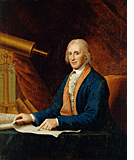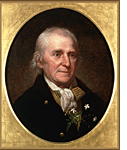


Few portraits of American men of science were painted during the years of the Revolution, when correspondence with European colleagues was interrupted and leisure for scientific investigation was lost. The acquisition of national independence, however, created a desire to demonstrate uniquely American achievements, and gave rise to a new, public image of the ideal man of science. After years of service to the revolutionary cause, Franklin longed for private life and philosophical studies. He wrote to a friend in 1785, "I have instruments if the Enemy did not destroy them all, and we will make Plenty of Experiments together." David Rittenhouse, the instrument maker who had succeeded Franklin as president of the American Philosophical Society, was, like Franklin, regarded as an American scientific genius. At the time of his death in 1796, Rittenhouse was promoted as an American Newton a worthy heir to the great British philosopher. His portrait by Charles Willson Peale, published as a mezzotint in 1796, depicts him as an astronomer in his study, wearing a banyan, gesturing to diagrams of the solar system and that of a comet, and posed beside a large reflecting telescope. This instrument may have been the one that Franklin owned and bequeathed to Rittenhouse.
The acquisition of national independence, however, created a desire to demonstrate uniquely American achievements, and gave rise to a new, public image of the ideal man of science. After years of service to the revolutionary cause, Franklin longed for private life and philosophical studies. He wrote to a friend in 1785, "I have instruments if the Enemy did not destroy them all, and we will make Plenty of Experiments together." David Rittenhouse, the instrument maker who had succeeded Franklin as president of the American Philosophical Society, was, like Franklin, regarded as an American scientific genius. At the time of his death in 1796, Rittenhouse was promoted as an American Newton a worthy heir to the great British philosopher. His portrait by Charles Willson Peale, published as a mezzotint in 1796, depicts him as an astronomer in his study, wearing a banyan, gesturing to diagrams of the solar system and that of a comet, and posed beside a large reflecting telescope. This instrument may have been the one that Franklin owned and bequeathed to Rittenhouse.
One of the many portraits created in the years following the Revolution represents America's leading botanist, William Bartram. In 1808 Charles Willson Peale created a portrait of Bartram for the gallery of heroes of the Revolution and persons of accomplishment in Peale's Philadelphia museum. It pays tribute to Bartram's long career, and through the inclusion of a sprig of fragrant jasmine, links Bartram to a portrait of Carl Linnaeus, the famous Swedish founder of the system of binomial nomenclature so admired by eighteenth-century botanists, and used by Peale to classify the specimens displayed in his museum. This portrait, like most of those included in "Franklin & His Friends," is a complex image that reveals far more than the likeness of a kindly old man. It works on many levels to present Bartram as a man of science, linked to the larger Enlightenment republic of letters, and yet it was also intended to serve as an exemplar of national accomplishment for Peale's museum audience.
It pays tribute to Bartram's long career, and through the inclusion of a sprig of fragrant jasmine, links Bartram to a portrait of Carl Linnaeus, the famous Swedish founder of the system of binomial nomenclature so admired by eighteenth-century botanists, and used by Peale to classify the specimens displayed in his museum. This portrait, like most of those included in "Franklin & His Friends," is a complex image that reveals far more than the likeness of a kindly old man. It works on many levels to present Bartram as a man of science, linked to the larger Enlightenment republic of letters, and yet it was also intended to serve as an exemplar of national accomplishment for Peale's museum audience.
The desire to assert a connection with the republic of learning, to participate in the project of the Enlightenment, and to create images that emphasized the scientific life were strong among men of science during the years surrounding the American Revolution. The resulting portraits form a great resource for the study of American art history, but they also enrich our knowledge of the many individuals who contributed to the history of early American science.
Benjamin Franklin / Charles Willson Peale / oil on canvas / Historical Society of Pennsylvania
David Rittenhouse / Charles Willson Peale / oil on canvas / National Portrait Gallery, Smithsonian Institution
David Rittenhouse / Edward Savage after Charles Willson peale / mezzotint / National Portrait Gallery, Smithsonian Institution
John Jeffries / Caroline Watson after John Russell engraved frontispiece to his Narrative / National Portrait Gallery, Smithsonian Institution
Thomas Jefferson / Cornelius Tiebout / stipple engraving / American Philosophical Society
Simeon DeWitt / Ezra Ames / oil on canvas / Jane Voorhees Zimmerli Art Gallery, Rutgers University
The Morse Family / Samuel F. B. Morse / watercolor on paper / National Museum of American History, Smithsonian Institution
William Bartram / Charles Willson Peale / oil on paper on canvas / Independence National Historical Park Collection